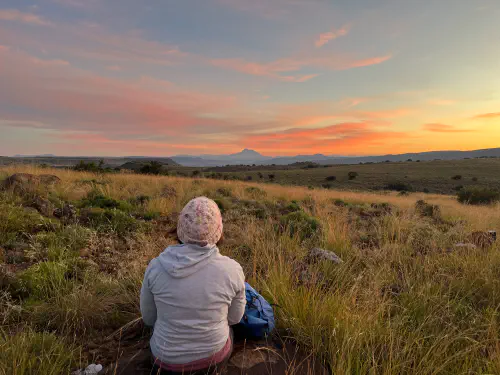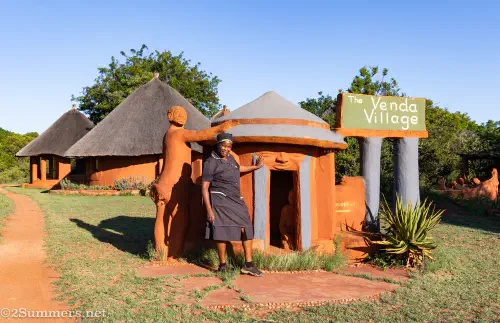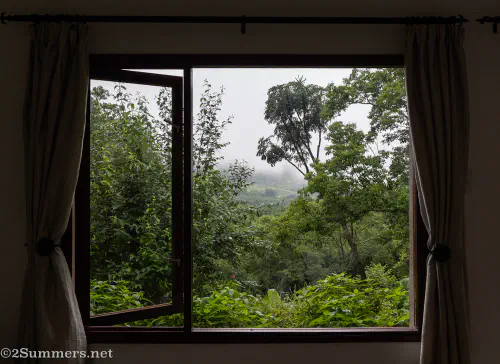The Blogitects Hike to Maletsunyane Falls
Back in April, the Blogitects took a long-anticipated road trip to the remote highlands of Lesotho to see Maletsunyane Falls. It was early April, after weeks of heavy rain, so the falls were overflowing and the mountains were greener than Kermit the Frog.

Maletsunyane Falls is 192 meters (630 feet) tall. Depending on where you look on Google, it’s either the highest or second highest single-drop waterfall in Africa. (Tugela Falls is much higher but it’s not single-drop.) Height specifics aside, Maletsunyane Falls is spectacular – I think this region of Lesotho is one of the most underrated tourist destinations in Southern Africa. Thorsten, who had never been to Lesotho before, said it was one of the best trips of his life.
How We Got to Semonkong
Thorsten and I went to Semonkong after our epic journey up Sani Pass (see my recent post). We drove from Underberg, South Africa (where we stayed before and after driving Sani Pass), to Semonkong, via the Qacha’s Nek border crossing. It was a beautiful drive that was supposed to take 5-6 hours but took more like 7-8, due to poor roads on the South African side of the border. Once we crossed into Lesotho, the roads were great.



We were slightly confused when we arrived at Semonkong. The route to the lodge took us straight through a bustling village, dodging dogs, donkeys, and dongas, and we thought maybe we were going the wrong way. We also had to drive across a shallow river to get to the lodge, which would have made me nervous in a low-clearance vehicle. But we arrived at the lodge with no issues. Plenty of other people seemed to be driving there in regular cars.
Staying in Semonkong
Semonkong Lodge, where we stayed for two nights, is a fun place – kind of like an upscale hostel. Accommodation options include en-suite rondavels, dorms, and camping. There’s a restaurant called the Duck and Donkey that serves hearty food.

If you stay in a rondavel, as we did, be warned that the rondavels are at the top of a steep hill – you must climb about 160 stairs to reach them. Also the power switches off every night from 10 p.m. to 8 a.m.


The lodge offers several adventurous activities, including pony treks, guided hikes, a “donkey pub crawl” in the village, and abseiling down Maletsunyane Falls (yes, that’s right). Apparently this is the tallest commercial abseil in the world, and you have to train on a smaller cliff near the lodge before attempting the real thing. The Blogitects are adventurous people, but not that adventurous, so we settled for a day hike to the falls.
Visiting Maletsunyane Falls
The walk from Semonkong to Maletsunyane Falls is relatively short – about four kilometers each way, depending on how much you meander – through a sparsely populated, pastoral area. We didn’t have cell service and had only a rough paper map with some verbal notes from the lodge staff, like “turn right at the unfinished house”, “walk beyond the sheep-shearing shed”, etc.

The walk was extremely enjoyable, even though we had to ford some very large, deep mud puddles and Thorsten almost drowned in one of them. (Next time we hike to Maletsunyane Falls, we’re bringing gum boots.) I’m glad we did the walk on our own, without a guide; it was fun to meander through the countryside at our own pace and it was pretty hard to get lost.




A couple of hundred meters before the falls, there is a guard hut where you pay a visitor’s fee of R120 (about $6.75). The security guard didn’t speak English and wouldn’t let us pay him – it turned out he needed to call another guy to come take our money – but we walked off before understanding that. We wound up paying the fee on our way back.
After passing the hut, we could hear crashing water and saw the mist rising. We rounded a bend and there they were.


Seeing Maletsunyane Falls for the first time was a mind-bending experience, and not just because of the physical spectacle. I almost couldn’t believe – staring across that canyon at such a majestic sight – that we were the only tourists there, together with a couple of shepherds, a herd of cows, and a young boy who might have been helping the shepherds.

We spent at least two hours walking along the cliffside, gazing at the falls from different angles, lounging around on rocks, listening to cowbell music, and reveling in the extraordinary solitude. We watched a pair of vultures (either bearded vultures or Cape vultures – I’m not sure which) soaring in and out of the canyon.
At one point the little boy sauntered up to Thorsten and asked if he had come to see the waterfall. Thorsten said yes. The boy smiled and said, “I get to see it every day!”



It is possible to hike down to the base of the falls, but I think that’s best done with a guide and we were happy to enjoy the views from above. If you have the right equipment, you can camp right in front of the falls. It’s also possible to drive to a waterfall viewpoint from the main road, but apparently the route is rough and requires a high clearance vehicle. I meant to try to drive there on our way out, just to see what it’s like and report back, but we didn’t get around to it.
We noticed a big, ugly building on a bluff overlooking the falls, which is apparently a new visitor center. It would have been a longish, uphill walk to get there so we didn’t go. But we heard later that there’s not much in it except an overpriced restaurant. If anyone reading this has viewed the falls from the road or visited the visitor center, I’d love to hear about your experience.
We were tired by the time we got back to the lodge that afternoon, especially after climbing 160 steps to our rondavel at the end of the hike. We enjoyed one more Semonkong sunset, dinner at the Duck and Donkey, and checked out the next morning.

We left Semonking in the opposite direction from which we came, driving northwest, through the capital city of Maseru and back into South Africa at the Maseru border post.

If you live in South Africa and haven’t been to Lesotho yet, seriously, what are you waiting for?! This trip was epic. If you have any questions, please ask.




Comments